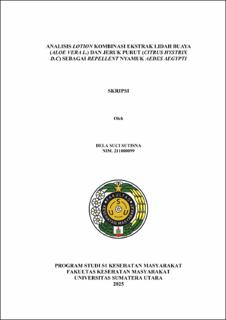| dc.description.abstract | Repellent lotion is an effective form of individual protection in reducing the risk of dengue transmission. However, many products contain synthetic chemicals that may cause toxicity to humans, resistance in mosquitoes, and environmental contamination. This condition highlights the importance of innovation in natural active ingredients that are effective, have minimal negative impact, and use locally available materials. This study aimed to analyze the physical, chemical, and biological characteristics as well as the effectiveness of lotion combining Aloe vera (Aloe vera L.) and kaffir lime (Citrus hystrix D.C.) extracts as a repellent against Aedes aegypti. The study used a quasi-experimental method with a Completely Randomized Design (CRD). Samples consisted of 600 female Aedes aegypti mosquitoes tested using the arm-in-cage method for 30 seconds at 6-hour intervals. Treatments consisted of four lotion concentrations (6,25; 12,5; 25; and 50 %), a negative control (lotion base), and a positive control (13% DEET). Results showed that the 50 percent concentration had the highest protection (43.6%), while the lowest was at 12.5 percent (28.3%). Organoleptic test showed the highest score in the positive control (8.8) and the lowest at 25 percent (7.4). The lotion remained homogeneous until day 7, had a stable pH (5–7), and caused no allergic reaction within 24 hours based on the patch test. Based on Kruskal–Wallis and Post Hoc Pairwise Comparisons, all concentrations were proven effective as repellent lotion, with 50 percent showing the highest protection, indicating potential as a safe and environmentally friendly natural repellent. Further studies are expected to use steam distillation or solvent fractionation methods to reduce pigment content, thereby producing lotion preparations that are more aesthetic and acceptable to society. | en_US |


